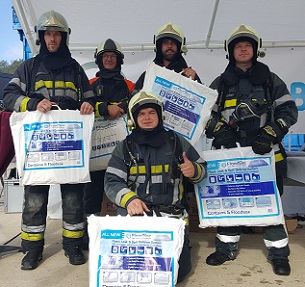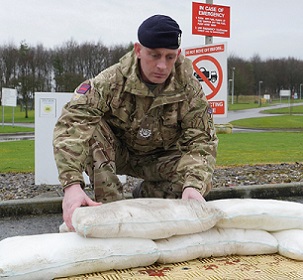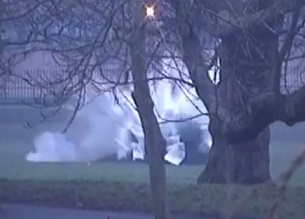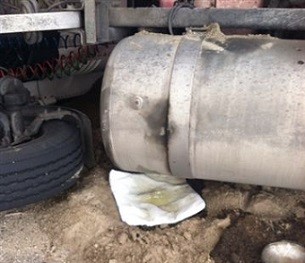 Firefighters with FloodSax alternative sandbags
Firefighters with FloodSax alternative sandbags
 A soldier deploying FloodSax alternative sandbags
A soldier deploying FloodSax alternative sandbags
 FloodSax sandless sandbags mitigated this controlled explosion in a London park
FloodSax sandless sandbags mitigated this controlled explosion in a London park
 FloodSax soaking up dripping diesel after a lorry crash
FloodSax soaking up dripping diesel after a lorry crash
 A soldier using BlastSax sandless sandbags to mitigate an IED
A soldier using BlastSax sandless sandbags to mitigate an IED
How the armed forces and emergency services use FloodSax and BlastSax alternative sandbags
The emergency services and armed forces both use alternative sandbags devised by a British company.
The fire service uses FloodSax while the armed forces and specialist police units worldwide use a military version of the FloodSax, a BlastSax. Both were invented by Environmental Defence Systems Ltd based in Yorkshire, England.
FloodSax and BlastSax both work in the same way. They come vacuum-packed which means they are space-saving to store and very light to take to where they are needed … and in the army this can be in the most remote or inaccessible places.
In their dry state both FloodSax and BlastSax are very thin with a large surface area so soak up water, often in the hardest to reach places.
But immerse them in water and the gelling polymer in the FloodSax or BlastSax absorbs up to 20 litres and retains it, transforming it into an instant sandbag but without any sand.
One of the most dramatic ways FloodSax were used happened in 2015 when they were deployed like BlastSax in an emergency. An unexploded World War Two bomb was found in a garden in Stoke Newington, London, so was taken to a nearby park and surrounded by FloodSax before it was detonated to reduce the impact of the explosion.
Read more about that here: https://www.hackneycitizen.co.uk/2015/01/05/live-world-war-two-bomb-exploded-clissold-park/
Firefighters have often used FloodSax to prevent contaminated water from getting into the drains or water courses at road accidents and building fires. They have even been used to soak up fuel spills. FloodSax are used by fire services in the UK, Europe and the USA.
FloodSax have been endorsed by the National Disabled Fire Association as they are so easy for anyone to store and deploy, especially the elderly and frail, to protect their homes from internal escapes of water or external flooding.
Chairman Duncan White said: “Having seen FloodSax in operation and witnessed the versatility and simplicity of their operation I was able to fully support endorsing FloodSax as a product designed with disabled people and the elderly very much in mind.
“This lightweight and compact system will ensure that the most vulnerable members of our communities will be better prepared in the event of a threat from flooding.”
A voluntary rescue service now uses FloodSax and promotes them wherever they go as they are so much lighter and easier to transport than sandbags which are so heavy and difficult to take anywhere.
Norfolk and Suffolk 4x4 Response carry FloodSax on their vehicles to get them quickly to people facing imminent threat of flooding.
BlastSax have undergone tough and demanding tests with the British armed forces to prove they are effective at mitigating the damage to people and property caused by IEDs, other explosive devices and bullets.
One person can carry 40 BlastSax at one time in dry state – equal to 800kgs sandbag weight - and they can be used with aqueous decontaminants to neutralise CBRN (chemical, biological, radiological and nuclear) threats. They are ideal for conventional demolition, minefield clearance, combat engineering, personnel protection when preparing detonators, IED applications, pipe bombs, CBRN tasks, blast protection in sensitive locations where collateral damage is unacceptable and to prevent flooding.
They are also extensively used by specialist police units in Hong Kong. The city was bombed during World War Two and unexploded bombs continue to be unearthed during building projects. BlastSax are often used to surround the bomb while it is being defused to mitigate the impact of any explosion.
BlastSax have been shown to be more effective than sandbags at capturing fragments from explosive devices, helping forensic teams gather evidence. They have also proven to be a reliable protective barrier against grenades and bullets fired by the standard British Army SA80A2 rifle with an official army report stating: “Even at extremely close ranges the BlastSax were able to contain the round. The BlastSax were able to offer excellent protection against this calibre of weapon.”
Even when grenades land on or very close to BlastSax they are able to absorb most of the fragmentation.
BlastSax were also tested by an army bomb squad in the USA.
Their report concluded: “This trial seemed to prove the effectiveness of the BlastSax in a blast mitigation role, more specifically in reducing the blast wave and capturing the fragmentation for forensics. The BlastSax system could prove effective against unexploded ordnance, IEDs, small incendiary devices, small dirty bombs (when the water used is combined with a tropical bleach) and other small scale Homeland Security threats.”
Environmental Defence Systems managing director Richard Bailey said: “We invented BlastSax after the Ministry of Defence approached us asking for an easily portable version of a sandbag that could mitigate the effect of explosions and do everything else expected of a sandbag.
“After a great deal of research and testing we devised the BlastSax which has proved to be highly effective, especially when dealing with smaller improvised explosive devices.
Richard added: “After we’d finished testing with the MoD the UK was hit by severe flooding and we were then tasked by the British Government to make a version of a sandless sandbag for flooding, meeting strict criteria set by the Environment Agency and the Government.”
This led to a civilian version of the BlastSax called a FloodSax which became the original sandless sandbag and are now seen as the ‘go to’ alternative to traditional sandbags.
For more on BlastSax go to http://blastsax.com/
For more on FloodSax go to https://www.floodsax.co.uk/